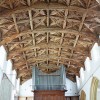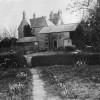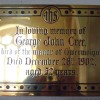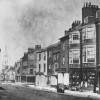St. Aldhelm’s Chapel sits high above the sea, a short distance from the edge of the promontory that has taken its name. This lonely wind battered little place of worship has been here for centuries; its priests would have stood and watched proud ships sail majestically by to take their place in history and those same men of God will have prayed for the souls of those aboard vessels caught by the storms that often rage here disturbing the sea some three hundred feet below.
Dedicated to a man who was born in the Wessex area around 640, he was likely the son of a high and noble family who would have been new converts to Christianity, probably only a few years before his birth. It is known he studied at Malmesbury, later visiting Canterbury before travelling to Rome.
On his return he established a monastery at Malmesbury. A leading scholar of his day, he was a charismatic man who went about his business with an evangelical zeal. In 705 AD, four years before his death, he departed from Malmesbury and was consecrated the first Bishop of Sherborne.
The cross on top of this ancient monument announces its Christian purpose; without that there is nothing easily visible outside to suggest this is a house of God. The plan and orientation – the corners equal the points of the compass – do nothing to suggest ecclesiastical use and it is known to be the only chapel in England with no east wall. It is likely that its construction was as a defensive lookout post for Corfe Castle as much as a spiritual home for the small Christian community who had been here before the 12th century. This is evidenced by earthen mounds that surround the chapel, which is thought by experts to have been built over an earlier timber building.
The Chapel was built in the 12th century and is of coursed rubble, its pyramid-shaped roof covered with stone slates. Entered through the round-arched Norman doorway the interior is a single room with a single central pier from which spring arches under a vaulted roof, the bare unplastered walls dribbling on to a stone flagged floor. Just enough light dances through the slim single-lancet window in the south-east wall to make out a 19th century font and an altar placed across the east corner.
As is so often the case we turn to John Hutchins to fill the gaps. He tells us the first mention of St. Aldhelm is in the reign of Henry III, when the Chapel of St. Mary at Corfe Castle and the Chapel of St. Aldhelm’s in Purbeck were each served by a chaplain paid fifty shillings per annum by the Crown. During the reign of Edward I it was rated at twenty shillings and later in 1428 St. Aldhelm’s continued to be taxed at twenty shillings but there were no inhabitants. John Aylworth sold to Bernard Gould the Manor of Renscombe including the advowson of the chapel of Renscombe – but is this a reference to St. Aldhelm’s? The chapel is clearly shown in a map dated 1737 as belonging to the Manor of Renscombe.
St. Aldhelm’s falls within the parish of Worth Matravers and the church guide says this about the chapel: “…It was believed that the chapel was originally a chantry, where a priest would celebrate mass for the safety of sailors; and it might well have been used for rest and prayer by kings, who often hunted in Purbeck…”
At the reformation the chapel would have become redundant and abandoned, the records appearing to confirm this. Chantries were suppressed by Edward VI. Another historian tells us that in 1625 this place served as a sea mark. Their has been some speculation that in earlier times a fire-beacon to aid sailors sat atop the chapel but the RCHM thinks this idea “untenable”.
Graffiti cut into the central column including dates show people continued to come here in the 17th century, even though the place was almost derelict. It was for some time used as a wishing chapel. Turning again to Hutchins (where would we be without him?) we learn that the roof had collapsed in places. Work started on repairs when the Scott family purchased Renscombe in 1811. A descendant, the 3rd Earl of Eldon, completed the restoration in 1873 paying all the costs and he provided a font and added the cross. More recently, on 4th of July 2005, The Most Reverend Dr. Rowan Williams, Archbishop of Canterbury, came here and consecrated the new altar table as part of the celebrations marking the 1300th anniversary of St. Aldhelm’s consecration as Bishop of Sherborne.
St. Aldhelm’s was fit for purpose again. H.J.Moule wrote in 1893: “On Whit Thursday, Worth Fair Day and club day, the people went with music to St. Aldhelm’s. decked the grey sombre interior with flowers and danced there.” Moule also said it was used at that time as a storehouse for the coastguards.
To this day people come from near and far to the chapel, some for the history and setting others come as pilgrim’s their purpose more spiritual. Legends, mysteries and superstitions run freely throughout the Isle of Purbeck and about this place there are tales to be told and examined, but we will keep them for another day.
There is a photo of the chapel in the photo section.



